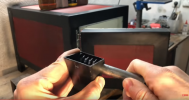Natlek - I think whether low thermal mass is "good" depends on your objectives - and also I think the quote you have above is mixing two different things. the ability to get to temperature fast is a result of low thermal mass - BUT the uniformity of heating and ability to recover from placing something cold inside in an oven like this is dependent on the ability of the lining to absorb energy, then re-radiate it.
A high thermal mass lining will therefor have a more uniform temperature, and the resulting radiation field will likewise be more uniform. It will also be able to more quickly bring the oven back up to temp when you, say, put a cold knife blank in to it (the energy to heat that blank is already stored in the higher heat capacity lining instead of needing to wait for the energy to be delivered into the chamber by the electric coils). So ... bricks on the inside make sense to me.
But it is also true that higher insulation will reduce loss to the outside (likely also help with uniformity of temps in the oven), BUT a really high insulation value adjacent to the cavity will interfere with that absorb-re-radiate thing, and really interfere with the ability of the oven to recover from an open door or something cold being put inside.
so, from what we have talked about so far, I agree that the "best" design would be something like an inner lining of 1 inch bricks (thick enough to store that energy and give that thermal recovery), surrounded with blanket of something like 4-5 inches ... which would give you both the good insulation and effective local heat storage right at the cavity. I just cant buy 1 inch bricks, and dont want to cut down thicker ones.... :-(

